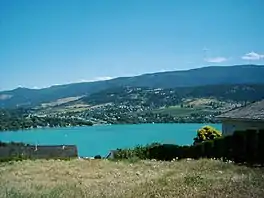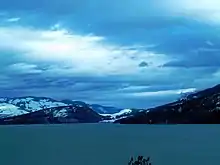Kalamalka Lake
Kalamalka Lake (a.k.a. "Kal Lake") is a large lake in the interior plateau of southern central British Columbia, Canada, east of Okanagan Lake. The lake is located approximately 4 kilometres (2.5 mi) south of the city of Vernon and is its main drinking water supply.[1][2] The lake is named after the Okanagan (Okanogan U.S. spelling) First Nation chief who occupied its northern shores.
| Kalamalka Lake | |
|---|---|
 | |
 Kalamalka Lake | |
| Location | Southern Central British Columbia |
| Coordinates | 50°10′25″N 119°19′48″W |
| Lake type | Glacial Lake |
| Primary inflows | Coldstream Creek, Vernon Creek, Oyama Creek |
| Primary outflows | Vernon Creek |
| Basin countries | Canada |
| Max. length | 16 km (52,000 ft) |
| Max. width | 3 km (9,800 ft) |
| Surface area | 25.7 km2 (9.9 sq mi) |
| Average depth | 58.5 m (192 ft) |
| Max. depth | 142 m (466 ft) |
| Water volume | 1.5 km3 (0.36 cu mi) |
| Residence time | 55.2 years |
| Shore length1 | 42.4 km (26.3 mi) (approx.) |
| Surface elevation | 392 m (1,286 ft) |
| Settlements | Coldstream, Lake Country |
| 1 Shore length is not a well-defined measure. | |
At different times of the year the colour of the lake can range from cyan to indigo, in different parts at the same time, earning the lake the moniker "lake of a thousand colours". The colour of the water is derived from light scattering, caused by the precipitation of calcium carbonate (CaCO3).
Hydrology
Kalamalka Lake is an oligotrophic, monomictic marl lake with high alkalinity and hardness.[2][3] From fall to spring the entire water column mixes and is thermally stratified in May through early November. During periods of warmer weather and increasing photosynthesis of phytoplankton, calcium, carbonate ions, and phosphorus in the water column precipitate, changing the colour of the water and increasing the turbidity.[3] As a result, calcium carbonate on vegetation at the shore and Charophytes may be present.[2]
The main inflow is from Wood Lake located to the south and connected by a canal at Oyama. The lake is drained by Vernon Creek[4] which exits at the north end, passes through the city of Vernon, and flows into the Okanagan Lake.
Tourism

Kalamalka Lake has several beaches. Kal Beach and Cosens Bay Beach are in the heart of Kalamalka Lake Provincial Park. Some of the other beaches on this lake are Jade Bay Beach, Juniper Bay Beach, Kekuli Bay Beach, Kirkland Park Beach, and on the south end, Kaloya Regional Park Beach.
Two provincial parks are situated along Kalamalka Lake, Kalamalka Lake Provincial Park and Protected Area[5] (4209 ha) and Kekuli Bay Provincial Park[6] (57 ha).
There are many resorts on the lake including Tween Lakes Resort and Klub Kal. Kalamalka Lake receives very little fishing pressure and is used mostly for recreational boating and water skiing. Tween Lakes Resort is currently the only marina on the lake with a fuel dock.
References
- "Kalamalka Lake". BC Geographical Names.
- "The Importance of Kalamalka Lake & its Watershed" (PDF). BC Lake Stewardship Society and the Ministry of Environment.
- "Kalamalka Lake Water Quality Study: Microflora, Water Chemistry & Thermal Profiles 2014". Larratt Aquatic Consulting Ltd. for Greater Vernon Water and District of Lake Country.
- http://www.obwb.ca/fileadmin/docs/okanagan_basin_map.pdf
- "Kalamalka Lake Provincial Park". Archived from the original on 2004-04-05. Retrieved 2004-03-08.
- "Kekuli Bay Provincial Park - BC Parks".
- Anonymous (1974a). Kalamalka-Wood Lake Basin Water Resource Management Study. Water Investigations Branch, British Columbia Water Resources Service, Victoria, B.C., 209 pp.
- Anonymous (1974b). Limnology of the Major Lakes in the Okanagan Basin. Canada - British Columbia Okanagan Basin Agreement, Final Report, Technical Supplement V. British Columbia Water Resources Service, Victoria, British Columbia, 261 pp.
- Anonymous (1974c). The Main Report of the Consultative Board. Canada - British Columbia Okanagan Basin Agreement. British Columbia Water Resources Service, Victoria, British Columbia.
- Stockner, J.G. and Northcote, T.G. (1974). Recent limnological studies of Okanagan Basin lakes and their contribution to comprehensive water resource planning. Journal of the Fisheries Research Board of Canada, 31, 955-976.
External links
- Natural Resources Canada. Atlas of Canada. Map of Kalamalka Lake
